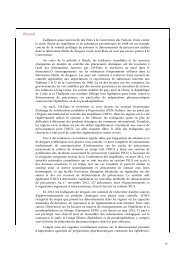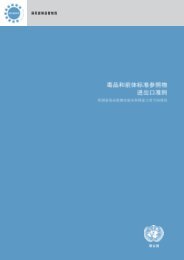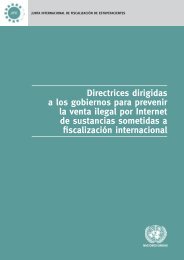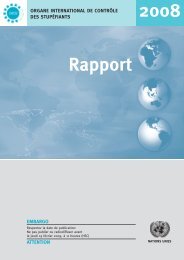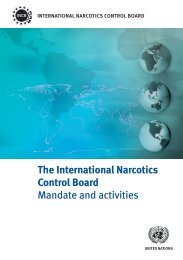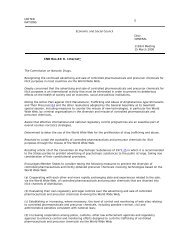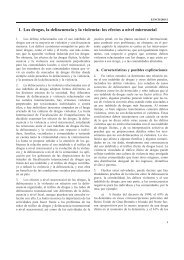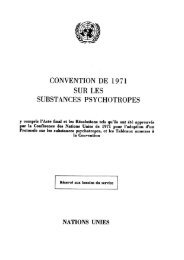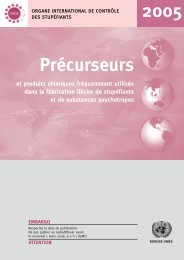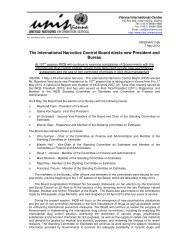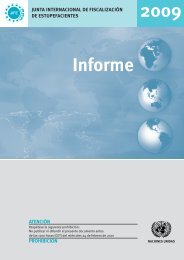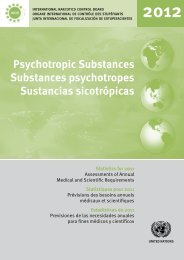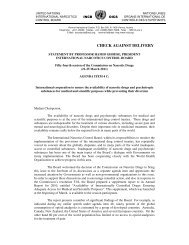List of Psychotropic Substances under International Control - INCB
List of Psychotropic Substances under International Control - INCB
List of Psychotropic Substances under International Control - INCB
You also want an ePaper? Increase the reach of your titles
YUMPU automatically turns print PDFs into web optimized ePapers that Google loves.
Part one. <strong>Substances</strong> in Schedules I, II, III and IV <strong>of</strong> the Convention on<br />
<strong>Psychotropic</strong> <strong>Substances</strong> <strong>of</strong> 1971<br />
<strong>Psychotropic</strong> substances <strong>under</strong> international control are presented in the schedules below. Where an<br />
international non-proprietary name (INN) is available for a substance, that INN is given in the left-hand<br />
column. Where no INN is available, the non-proprietary or trivial names <strong>of</strong> the substance are given in the<br />
second column <strong>of</strong> the table. Where a trivial name is commonly applied to a substance with a given INN, then<br />
the trivial name is also given in the second column. Salts <strong>of</strong> all the substances covered by the four schedules,<br />
whenever the existence <strong>of</strong> such salts is possible, are also <strong>under</strong> international control.<br />
The following interpretation guidelines2 concerning the stereoisomers <strong>of</strong> substances in Schedules II, III and IV<br />
<strong>of</strong> the 1971 Convention3 were developed, pursuant to Commission on Narcotic Drugs decision 42/2, in order to<br />
clarify the scope <strong>of</strong> control <strong>of</strong> stereoisomers <strong>of</strong> substances in those schedules:<br />
(a) When the substance listed can exist as stereochemical variants the following should apply:<br />
(i) If the chemical designation <strong>of</strong> the substance used in the 1971 Convention (or in a subsequent<br />
scheduling decision <strong>of</strong> the Commission on Narcotic Drugs does not include any stereochemical<br />
descriptors or indicates a racemic form <strong>of</strong> the substance:<br />
a. If the molecule contains one chiral centre, both the R- and S-enantiomers and the<br />
RS-racemate are controlled, unless specifically excepted by a decision <strong>of</strong> the Commission on<br />
Narcotic Drugs;<br />
b. If the molecule contains more than one chiral centre, all the diastereoisomers and their<br />
racemic pairs are controlled, unless specifically excepted by a decision <strong>of</strong> the Commission on<br />
Narcotic Drugs;<br />
(ii) If the chemical designation used in the 1971 Convention (or in a subsequent scheduling<br />
decision <strong>of</strong> the Commission on Narcotic Drugs) for the substance which contains one chiral centre<br />
in the molecule includes a stereochemical descriptor indicating a specific enantiomer, the racemic<br />
form <strong>of</strong> the substance is also controlled, unless specifically excepted by a decision <strong>of</strong> the<br />
Commission on Narcotic Drugs, while the other enantiomer is not controlled;<br />
(iii) If the chemical designation used in the 1971 Convention (or in a subsequent scheduling<br />
decision <strong>of</strong> the Commission on Narcotic Drugs) for the substance which contains more than one<br />
chiral centre in the molecule includes stereochemical descriptors indicating a specific<br />
diastereoisomer, only that diastereoisomer is controlled;<br />
(b) When one enantiomer is controlled, then a mixture <strong>of</strong> that enantiomer with the other enantiomeric<br />
substance is controlled;<br />
(c) The chemical designations and INNs used in the scheduling decisions to define substances in<br />
Schedules II, III and IV <strong>of</strong> the 1971 Convention were considered appropriate at the times when<br />
such decisions were made. It should be <strong>under</strong>stood that:<br />
(i) Alternative chemical designations constructed according to modified chemical nomenclature<br />
rules may be used in <strong>of</strong>ficial documents as long as they preserve the stereospecificity when<br />
appropriate;<br />
(ii) If any subsequent modification <strong>of</strong> an INN definition uses a chemical designation which is<br />
different to that in the scheduling decision, such an INN should be omitted from <strong>of</strong>ficial documents.<br />
In order to facilitate rapid identification <strong>of</strong> all scheduled psychotropic substances, CAS (Chemical Abstracts<br />
Service) registry numbers were included for the most traded substances (Schedule II, III and IV substances)<br />
and their salts. The list is not exhaustive and the absence <strong>of</strong> a CAS number does not mean that it does not exist but<br />
rather that it was not available at the time <strong>of</strong> the update <strong>of</strong> the list. CAS numbers were included in the following cases:<br />
__________________<br />
2 The guidelines are also applicable to the stereoisomers <strong>of</strong> substances in Schedule I, whenever the existence <strong>of</strong> such<br />
stereoisomers is possible within the specific chemical designation, which are <strong>under</strong> international control unless<br />
specifically excepted by a decision <strong>of</strong> the Commission on Narcotic Drugs.<br />
3 WHO Expert Committee on Drug Dependence: Thirty-second Report, WHO Technical Report Series No. 903 (Geneva,<br />
World Health Organization, 2001), annex.<br />
3



